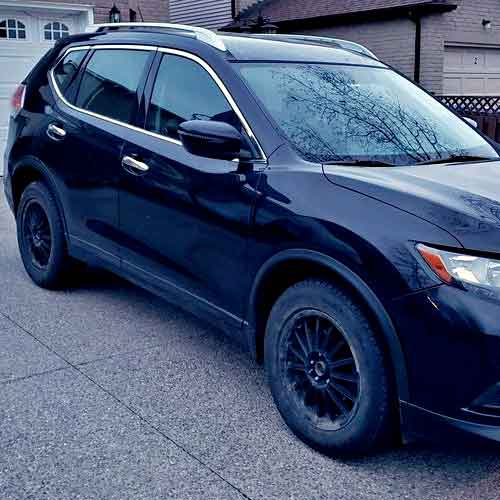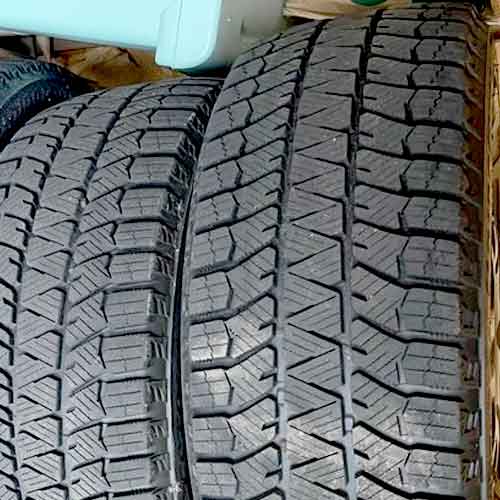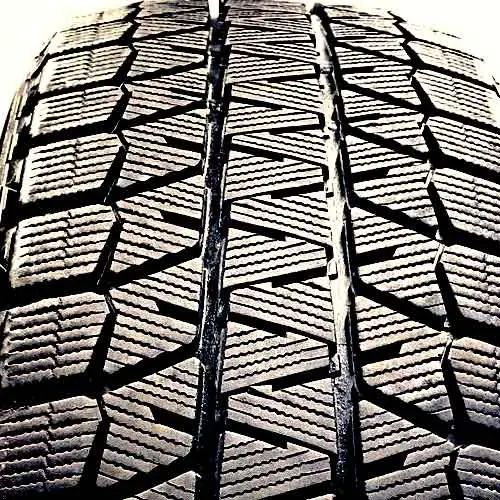Journey with us on an exhilarating ride as we pit two titans of the tire world against each other, the resilient Bridgestone Blizzak WS90 and its formidable predecessor, the WS80. This is not just a clash of rubber and road – it’s a showdown of engineering brilliance, design innovation, and the relentless pursuit of perfect performance. Let’s get things rolling.

Table of Contents
Tire Sizes
The Bridgestone Blizzak WS90 comes in 52 total sizes in 15 to 19 inches (wheels) with following specs.
- Speed ratings: T or H.
- Load ratings: SL or XL.
- Tread depth: 11 or 12/32″.
- Weight: 17 to 29 lbs.
- Tread warranty: None.
On the other side, the Blizzak WS80 (used to) come in 15 to 19 inches, with following specs.
- Speed ratings: H and T.
- Load ratings: SL or XL.
- Tread depth: 11 or 12/32″.
- Weight: 16 to 35 lbs.
- Tread warranty: None.
Tread Appearance
The The Bridgestone Blizzak WS90 (review) stands out as a durable winter tire, characterized by a thoughtfully arranged tread pattern. Let’s break down its unique elements.

When you examine the tire, you get to see that there are actually 3 ribs. So let me start with the outer ones first.
So these shoulder lugs are brimming with biting edges.
They feature diagonal full-depth notches aimed towards the center, along with similar notches aligned longitudinally.
(This dual direction notch alignment enhances the tire’s traction).
In addition, towards the tire’s edges, you’ll notice zigzag slits running lengthwise, and as you’d expect, there’s a lot of wave-like siping here.
Moving towards the middle, the rib here is made continuous.
It contains full depth notches (just as seen on the notches). And these join up with the V shaped biters facing in both directions.
And yes, of course, there’s a lot of multiple-angles full depth siping here as well.
On the other hand, also features a directional pattern.

If you divide the tread into parts, you’ll find three ribs in the middle that look like columns of blocks.
This forms four channels that run the length of the tire.
The middle rib is a single piece just like it’s predecessor, as lugs here are sitting on a continuous running secondary rubber layer.
But unlike the WS90, this rib creates more biting edges, due to the lugs placed with an off-set.
Though, you do get similar in-groove notches and siping design, nonetheless.
Same goes for the shoulder lugs, apart form the slightly angle orientations of the sipes, and biters, you get almost similar shoulders here as well.
Dry Grip
Dry traction, a crucial aspect of tire performance, largely hinges on the design of the tire’s central tread area. This is because, during straight-line driving, the center of the tire bears the most weight pressure on itself.
That’s why it makes sense why out of both tires, the Bridgestone Blizzak WS90 comes out better.
The tire features a more streamlined central most rib, featuring fewer offset edges along its sides compared to its predecessor.
This configuration allows for a larger rubber-to-road contact area, leading to improved grip and shorter braking distances on dry roads.
On the other hand, the opposite happens on the Blizzak WS80, which besides featuring less streamlined design of its rib, also showcases larger tread voids/slanted incision.
So the overall braking efficacy of ws80 gets to be limited, relatively.
Dry Handling
Handling performance largely hinges on the design of shoulder lugs and the tire’s overall flexibility. And in this context, the Bridgestone Blizzak WS90 outshines its predecessor, by a lot of margin, I should add.
So why that’s the case?
Well because the Bridgestone WS90 is designed with a multitude of biting edges on its shoulder lugs, which also having narrower lateral grooves, interspersed, contribute to improved grip.
While on the flip side, the WS80’s lugs are thicker and have fewer biting edges, limiting its grip capacity.
However, a more significant factor influencing its overall poorer handling is its weight.
Basically, during cornering, the tire’s weight shifts towards its edges or shoulders, and the heavier WS80, under greater pressure, leads to increased flex in the lugs.
This flex results in delayed oversteer and understeer responses, limiting the tire’s overall responsiveness to steering inputs.
In contrast, the WS90’s lighter weight, coupled with its more flexible design, efficiently manages these cornering forces. Thus, it delivers superior handling performance, especially when navigating turns.
Tread Life
The longevity of a tire’s tread is significantly influenced by its rolling resistance, a factor governed by weight and tread design.
So to put things more simply, the lighter the tire, the better it fares in terms of tread life. The reason being, a lighter tire exerts less pressure on the road surface, thereby reducing friction and slowing the rate of wear.
So by this principle, the Bridgestone Blizzak WS90, with its lighter frame, prevails, as its lugs aren’t pushed as much against the ground. This leads to less friction/heat generation, and of course greater resistance to wear.
On the other side, the Blizzak WS80 not only lacks with its larger weight, but also with less overall streamlined lugs, and older rubber composition.
All of these factors puts this tire behind its newly updated WS90.
Noise Generation
Tire noise is primarily a byproduct of air particles colliding against the tread walls, with its volume often influencing the overall driving experience. Efficient noise management, therefore, becomes a crucial aspect of tire design.
In this respect, the Bridgestone Blizzak WS90 showcases an advantage over the Blizzak WS80, owing to a less voided tread pattern. Fewer voids equate to reduced air cavities for sound propagation, generating less noise as the tire rolls over the road. This design attribute renders the Blizzak WS90 a more silent performer, enhancing comfort levels for both driver and passengers.
Wet Traction
The effectiveness of a tire’s performance on wet surfaces is determined by the design of its sipes and the composition of its tread (rubber).
And in this regard, the Bridgestone Blizzak WS90 outperforms its counterparts across various subcategories including grip, handling, and hydroplaning resistance.
Basically, the Blizzak WS90’s latest rubber compound yields a more enhanced water dispersion capabilities, which significantly improve the tire’s traction on wet surfaces.
Additionally, its updated sipe design, featuring multiple angles, facilitates rapid water evacuation from the contact patch. This quick water clearing ability results in improved grip, particularly on wet roads.
Furthermore, its superior inter-connectivity of tread voids/grooves offer a better, and exceptional water channeling capabilities in all directions.
This robust design allows for higher hydroplaning resistance, giving the vehicle more control, even at higher speeds during straight-line and curved aquaplaning tests.
Fuel Economy
Fuel economy in tires is primarily determined by two factors: the tire’s interaction with the road surface and its overall weight. These aspects directly impact the tire’s rolling resistance, which plays a pivotal role in the vehicle’s energy consumption.
In this respect, the heavier Blizzak WS80 lags behind, with its weight forcing its lugs to flex more against the road, especially during maneuvers such as cornering. This flexing consumes extra energy that would otherwise contribute to the tire’s rolling motion.
The Bridgestone Blizzak WS90, lighter and crafted with longitudinally aligned ribs, offers superior aerodynamic efficiency compared to the larger-spaced pattern of the Blizzak WS80.
The result is smoother, more energy-efficient straight-line travel, like highway driving. Therefore, the Blizzak WS90 excels in terms of fuel economy.
Vibration Absorption
Tires are the initial shock absorbers against road irregularities. Think of them as secondary suspension systems of the vehicle.
And with the new gen compound, seen on Blizzak WS90, you get better results here.
The tire encounters uneven surfaces in a better way, its construction adeptly cushions these disturbances, yielding a smoother ride.
And yes, since, its lighter weight also offers better steering feedback, you get a more smoother ride experience on roads, compared to Blizzak WS80.
Ice Performance
On icy terrains, the Bridgestone Blizzak WS90 confidently steals the spotlight, braking an impressive 11 feet shorter than its predecessor on average.
This is because its tread pattern has a crafted blend of its next-generation tread compound and meticulously designed biters scattered all over. Let me explain.
So the WS90 sports an enhanced biter design, characterized by more streamlined, slanted incisions harmoniously teamed with V-shaped notches oriented in both lateral directions. This innovative design boosts the ice grip substantially.
And adding to that, is its more aggressive siping pattern which simply grips on icy surface in a much better way.
The Blizzak WS80 on the other side, lacks to its newer update on icy terrains. Though its surprisingly great when it comes to fluffier snow.
Fluffy Snow Performance
Navigating through fluffy snow differs greatly from handling ice, and in this scenario, the WS80 edges ahead with its marginally open tread design.
But why is that?
Well because of its biters, which are specifically designed to accommodate soft snow particles, effectively trapping them within the tire’s tread.
This process facilitates a more efficient snow-to-snow contact, which enhances traction because snow adheres more effectively to its own kind than to rubber.
Conversely, the Bridgestone Blizzak WS90 exhibits a minimalistic approach towards snow handling.
It has a more compact tread design characterized by aggressive tiny biters can’t retain as much snow, so overall you see a slightly lacking performance here.
So What’s the Verdict?
In this comparison between the Bridgestone Blizzaks, the WS90 is largely superior, as it offers improved dry traction and handling due to a more streamlined central rib and multiple biting edges on its shoulder lugs.
Moreover, the tire’s lighter frame also allows it to have superior fuel and tread efficiency, and its smaller tread voids leads to a quieter ride.
Moreover with a lot of intricate biters you also get superior wet and icy terrain traction.
Though in case of fluffy snow, the Blizzak WS80 has the upper hand still.